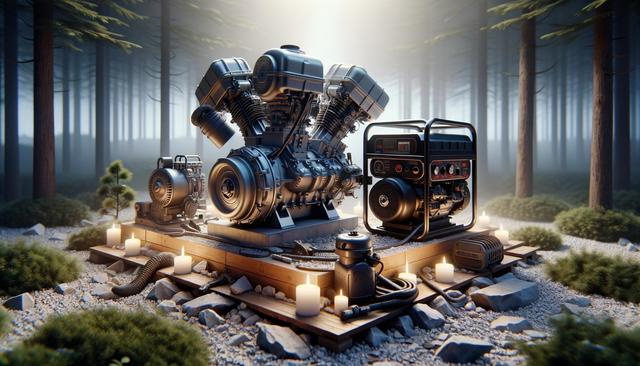The Role of the Gasoline Engine in Power Generation
At the heart of any portable or standby power system is the gasoline engine, which serves as the main driver of the entire setup. This internal combustion engine operates by igniting a mixture of gasoline and air within a cylinder. The explosion that occurs pushes a piston, creating mechanical motion. This motion is then transferred through a crankshaft, which ultimately serves as the source of rotational energy for the generator. Gasoline engines are popular due to their relatively compact size, ease of maintenance, and wide availability of fuel. They are often used in small to medium-sized generators that are suitable for home, recreational, or light commercial use.
Some key characteristics of gasoline engines include:
- Quick startup capabilities
- Lower noise levels compared to diesel engines
- Efficiency in intermittent use scenarios
Because gasoline engines are optimized for mobility and ease of use, they are an excellent match for generators intended for temporary or emergency applications.
How the Generator Converts Mechanical Energy to Electricity
Once the gasoline engine produces mechanical energy, the generator’s job is to transform that energy into electricity. This is achieved through the principle of electromagnetic induction. Inside the generator, a rotor (connected to the engine) spins within a magnetic field. This movement causes electrons to move along the winding of the stator, generating an electric current. The output can be either alternating current (AC) or direct current (DC), depending on the design.
Generators feature several core components that contribute to this conversion:
- Rotor and stator assembly
- Voltage regulator to control output consistency
- Cooling system to manage heat during operation
The generator relies entirely on the mechanical input from the gasoline engine, making synchronization between both systems critical for stable and reliable power output.
Synchronization Between Engine and Generator
For the system to function efficiently, the gasoline engine and the generator must operate in harmony. The engine’s speed directly affects the frequency and voltage of the electricity produced. Most generators are designed to run at a fixed RPM—commonly 3,600 RPM for portable units—which corresponds to the standard 60 Hz electrical frequency used in many regions. Any fluctuation in engine speed can lead to unstable voltage, which may damage sensitive electronics.
To ensure synchronization, many generator systems include:
- Governor systems to maintain consistent engine speed
- Automatic voltage regulators
- Integrated control panels for real-time monitoring
Proper calibration and maintenance are essential to keep the gasoline engine and generator operating in sync, especially during extended use or variable load conditions.
Applications and Use Cases
The combined setup of a gasoline engine and generator finds use across a wide range of scenarios. These systems are particularly helpful in remote locations, during natural disasters, or in off-grid living environments. Their mobility and availability make them a go-to option for temporary power needs.
Common applications include:
- Emergency backup power for homes
- Power supply for outdoor events and construction sites
- Electricity for recreational vehicles and boats
Users appreciate the convenience of gasoline-powered generators because they can be quickly deployed and refueled when needed. However, safety precautions are necessary, such as proper ventilation and fuel storage, to ensure safe and efficient operation.
Maintenance and Operational Considerations
Maintaining a gasoline engine and generator system involves regular checks to ensure both components work effectively together. Neglecting maintenance can lead to reduced efficiency, higher fuel consumption, and even system failure. Routine tasks include oil changes, air filter replacement, spark plug inspection, and fuel system cleaning. The generator itself may require periodic inspection of the brushes, bearings, and electrical connections.
Key maintenance tips include:
- Run the generator monthly to prevent fuel degradation
- Store gasoline safely and use stabilizers if storing long-term
- Follow manufacturer-recommended service intervals
By keeping both the gasoline engine and generator in optimal condition, users can extend the lifespan of their system and ensure reliable performance whenever power is needed.
Conclusion
Understanding how a gasoline engine and generator work together provides valuable insight into portable and backup power solutions. These systems offer a practical way to generate electricity where and when it’s needed most. Whether used for emergencies, outdoor activities, or remote job sites, regular maintenance and proper operation are key to ensuring dependable performance. By recognizing the roles of each component and how they function in tandem, users can make informed decisions on using and caring for their gasoline-powered generator systems.




Leave a Reply